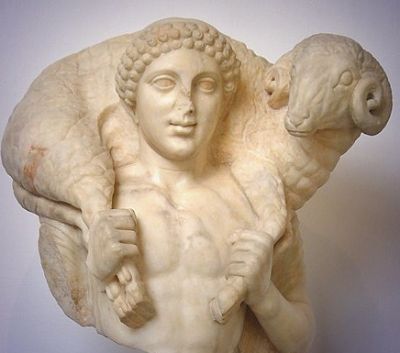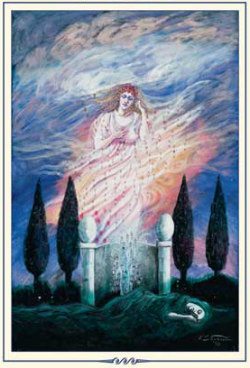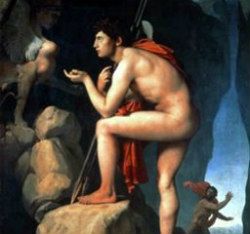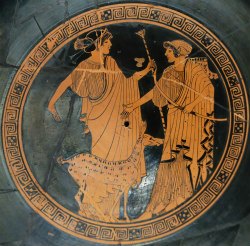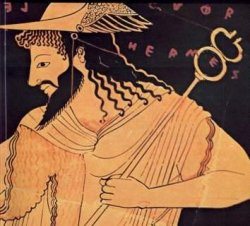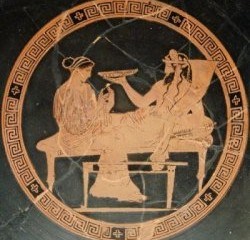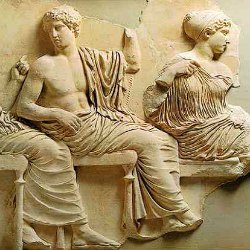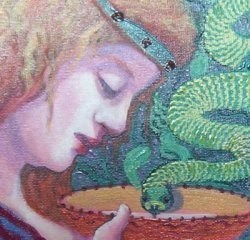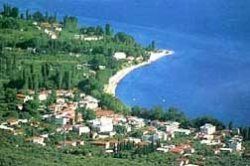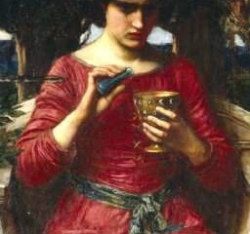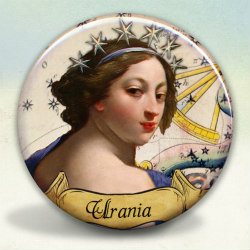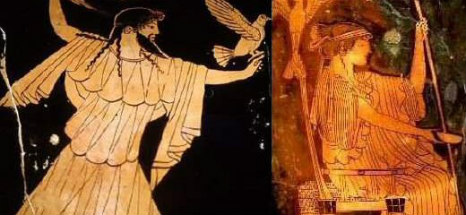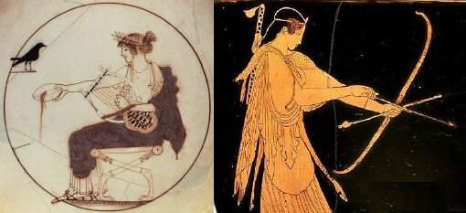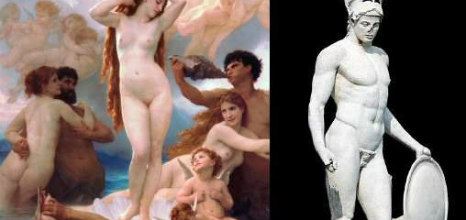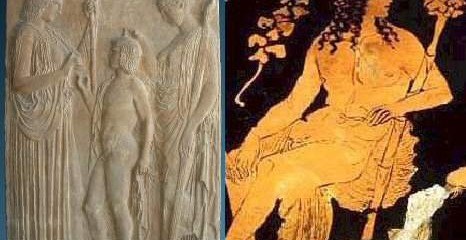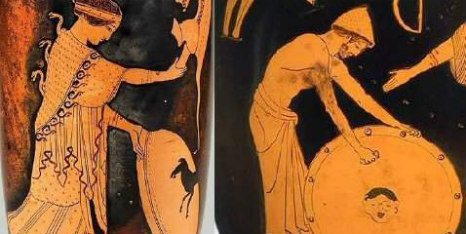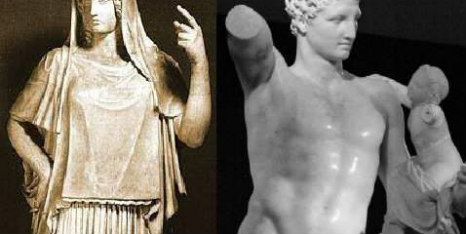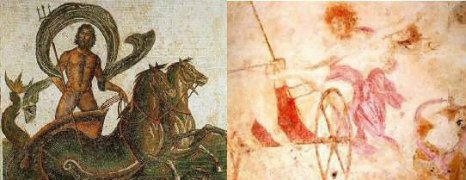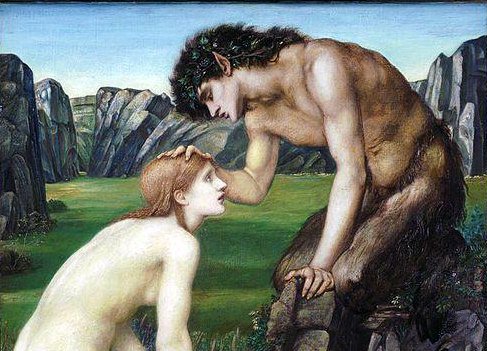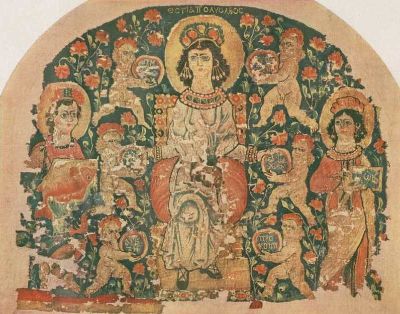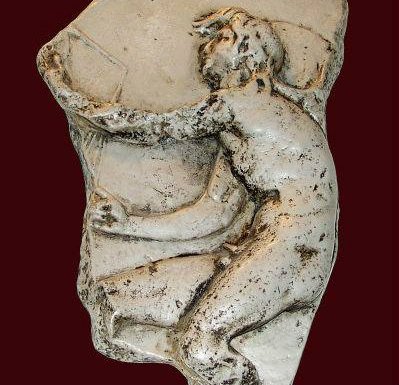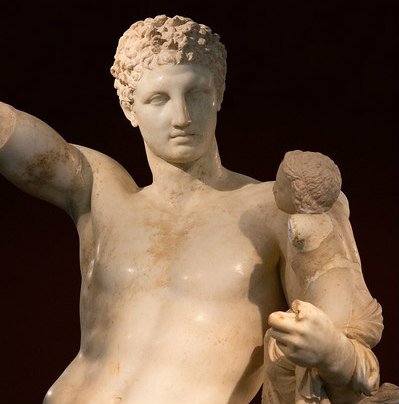Mythology Articles
The following Mythology articles have previously appeared in astrological magazines or websites. Please note all articles are copyrighted. If you wish to use any information published in any of these mythology articles, please contact Astro*Synthesis for permission.
Homage to the God of Transitions
Hermes is guide as we travel life’s highways and also patron when we are in the midst of transition. This article muses on his myth and how He bequeaths so many of his gifts and characteristics to us as we transition between the states of our union.
Image: Hermes Kriophoros (the ram-bearer)
Mnemosyne
Mordreth Boehm, the editor of the Conference Magician – an edition published for the Tarot Guild of Australia 2013 International Conference – asked me to contribute a short article on a favourite god or goddess.
Now that’s a difficult choice; who wants to offend any deity by favouring another?
But I decided to remember Mnemosyne, who as mother to the Muses is our soulful museum of felt experiences, images and mementos.
Freud and Oedipus
In preparing for our three-part seminar on Fate and the Soul using the three Sophocles’ tragedies Oedipus Rex, Oedipus at Colonus and Antigone, I was drawn to present a short piece on Sigmund Freud’s identification with the Oedipal myth.
As the vessel for Oedipus’ 20th Century reincarnation, Freud’s identification with the core character seemed to spring from a similar patterning.
I later reworked my thoughts as a short article presented here.
The Brother-Sister Marriage
In this article the archetype of the brother-sister marriage is explored both mythologically and psychologically.
For a more detailed version of this theme see The Sibling Constellation by Brian Clark (Penguin 1999) or Apollon, Issue No. 2.
Apollon was an outstanding journal dedicated to psychological astrology now available at http://www.cpalondon.com/apollon.html
Hermes as Guide and Leader of Souls
Hermes is known as a boundary crosser and one of the boundaries that he is able to cross over is the threshold to the underworld.
Multi-faceted Hermes leads the souls in and out of the underworld.
This article explores the background to his roles as psychopomp or guide of the souls as well as the many myths which depict his threshold crossing.
Hades as Place: The Landscape During a Transit of Pluto
Amplifying the underworld opens up our understanding of the process of Pluto as it transits the horoscope.
This article originally appeared in The Mountain Astrologer Special 100th Edition.
The Twin Motif in Comparative Mythology
When researching for my book The Sibling Constellation I became much more aware of the dynamic of twins and twinning. I was not surprised to find that myths from all cultures have very similar themes on twinship and how this very special relationship symbolises certain themes.
This article explores the cross cultural theme of twins.
An Asteroid Oracle: The Ancient Feminine Wisdom of Asteroid Goddesses and Heroines
The 2006 Wellspring AstroLog released a special addition of goddess oracle cards, based on 12 potent asteroid goddesses.
In this article Brian Clark explores the mythology and meaning of these asteroid goddesses including Ceres, Juno, Pallas Athena, Vesta, Hygieia, Ariadne, Europa, Pandora, Mnemosyne, Hecate, Cassandra, and Medea.
Esoteric Technologies – esotech.com.au – released a Goddess Report written by Brian and Stephanie Johnson astrologically detailing each of these goddesses.
Pelion: The Land Apollo Loved
The Pelion region is known as the home of the Centaurs and the summer playground of the Olympian gods.
But the region is also important in antiquity and in the following article Brian Clark meanders through some of the myths of the region.
This article originally appeared in The Wholistic Astrologer.
Whatever Happened to Medea’s Magic?
This is an excerpt of a talk I gave to the Victorian Association of Herbalists in 2002 musing on the loss of the magic and the mystery in herbalism and the art of healing in general.
The Muses of Heaven
Carole Taylor, the new editor of the Astrological Journal, UK asked me to contribute an article for the 1st edition she was planning featuring Astrology and the Imagination. The article appeared in the January / February 2014 edition of the Astrological Journal, Volume 56, No. 1 which was released in December 2013.
In this article I look at the early mythological images of Urania and Asteria as seminal figures that both reflected the interest in the heavens and were also muses and guides to understanding the imagination of the starry night sky.
As an astrologer the mythic narratives of the Gods and Goddesses have been invaluable in evoking images of the archetypes that underpin our planets and asteroids.
From the years of studying classics and teaching myth, I have collected some of my class notes, private papers and articles and fashioned some essays on the Olympians; hence the text like myth meanders through their biographies.
I have paired them together and included Hades who does not take a seat on Olympus and Hestia who is replaced by Dionysus in the classical period; therefore we have 14 deities generally presented as the more conventional and rational figure of 12.
The Olympians: Zeus and Hera
In this paper Zeus and Hera are explored through their sacred union as brother and sister; husband and wife.
The Olympians: Apollo and Artemis
Apollo and Artemis are the inseparable twins who move between culture and nature and are the deities personifying the Sun and Moon in the later periods.
The Olympians: Aphrodite and Ares
Aphrodite and Ares are eternal lovers, companions, sometimes siblings, sometimes married who become the underlying inspiration for the astrological archetypes of Venus and Mars.
The Olympians: Demeter and Dionysus
Demeter and Dionysus are agricultural gods of wheat and wine, powerful deities in the social and everyday fabric of ancient Greece.
The Olympians: Athena and Hephaestus
Athena and Hephaestus are explored for their contributions to the arts and crafts and for their civilising influences, albeit in very different ways.
The Olympians: Hestia and Hermes
Hestia and Hermes are deities evoked on thresholds, during transitional times and in liminal spaces and the inspiration for the asteroid Vesta and the planet Mercury. In the Homeric Hymn to Hestia they are paired together as the inner and outer guides for travelers on the road of life.
The Olympians: Poseidon and Hades
Poseidon and Hades are the potent archetypes associated with the otherworld and the underworld and the planetary personifications of Neptune and Pluto.
Gods in these times
The following four articles were written April 2020, during the Covid time of lockdowns. They were dedicated to Pan, Hestia, Kairos and Hermes.
Pan and the Pandemic
Article 1 in a series of 4 articles on Gods in these times
This piece emerged out of my musing about the times we are in, on our word Pandemic meaning ‘all people’ – and of Pan, the goat god who is commonly associated with Capricorn, and the god who lends his image to our word panic.
Image: Edward Burne-Jones, Pan and Psyche, 1872-4, Public Domain
At Home with Hestia
Article 2 in a series of 4 articles on Gods in these times
Governmental guidelines are directing us to stay home, to seek shelter in our home-place! We are called to Hestia’s hearth to regain our focus, relocate our centre, realign our values; home to spend time being contemplative and creative.
Image: Hestia Tapestry “Hestia full of Blessings”, 6th C Egypt.
Kairos
Opportunity in the Time of Capricorn
Article 3 in a series of 4 articles on Gods in these times
Kairos is more than a word; it is a symbol that characterizes timing and opportunities released by problems created in times of crisis. Chance is born out of the occasion of misfortune. Kairos implies that at times of tension and crisis, the ‘right’ time arises, but it is our choice to seize the opportunity…..
Image: Kairos – copy of relief from Lysippos
Transitioning with Hermes
through times of change
Article 4 in a series of 4 articles on Gods in these times
There is no doubt we are not only in transition collectively, but personally as well, as each of us are essential parts of the collective. In times of transition there is suspension as we cross the threshold – this is Hermes’ landscape –
Image: Hermes and the child Dionysus – Olympia museum

